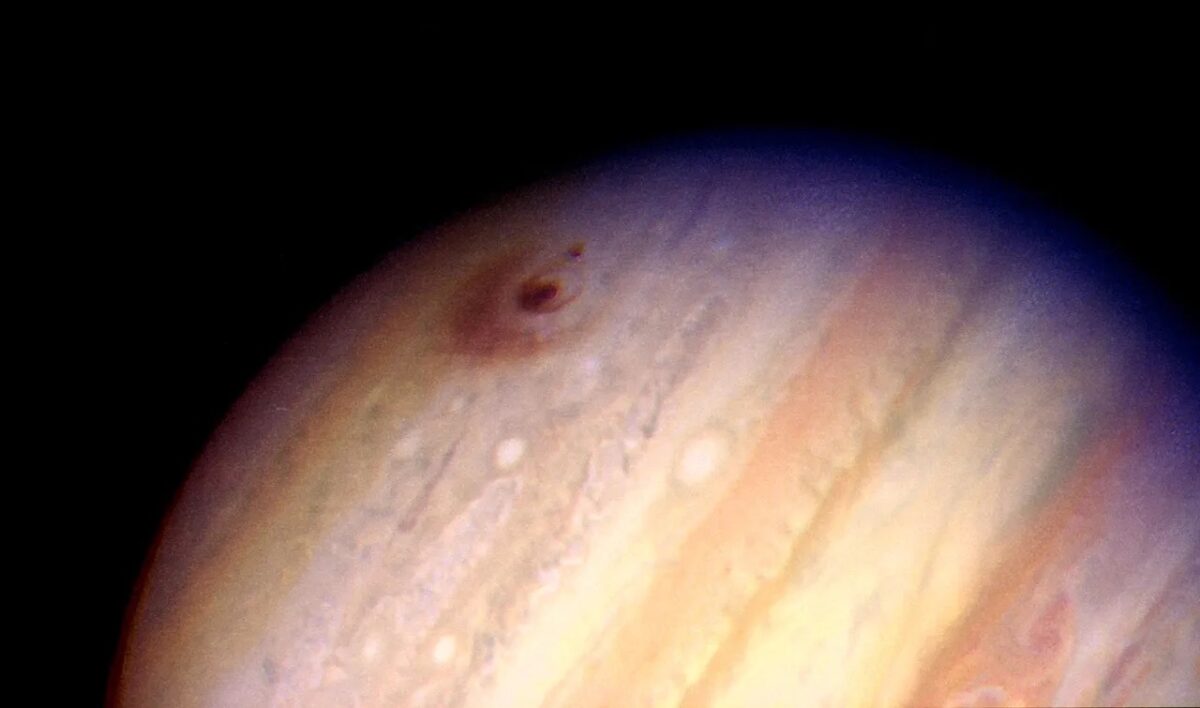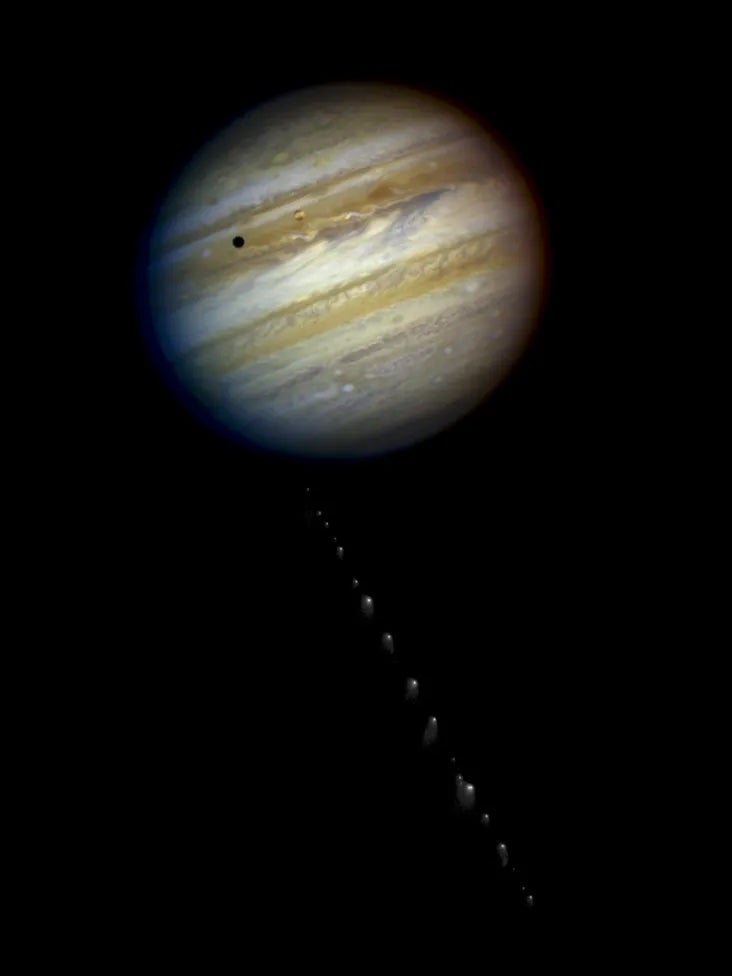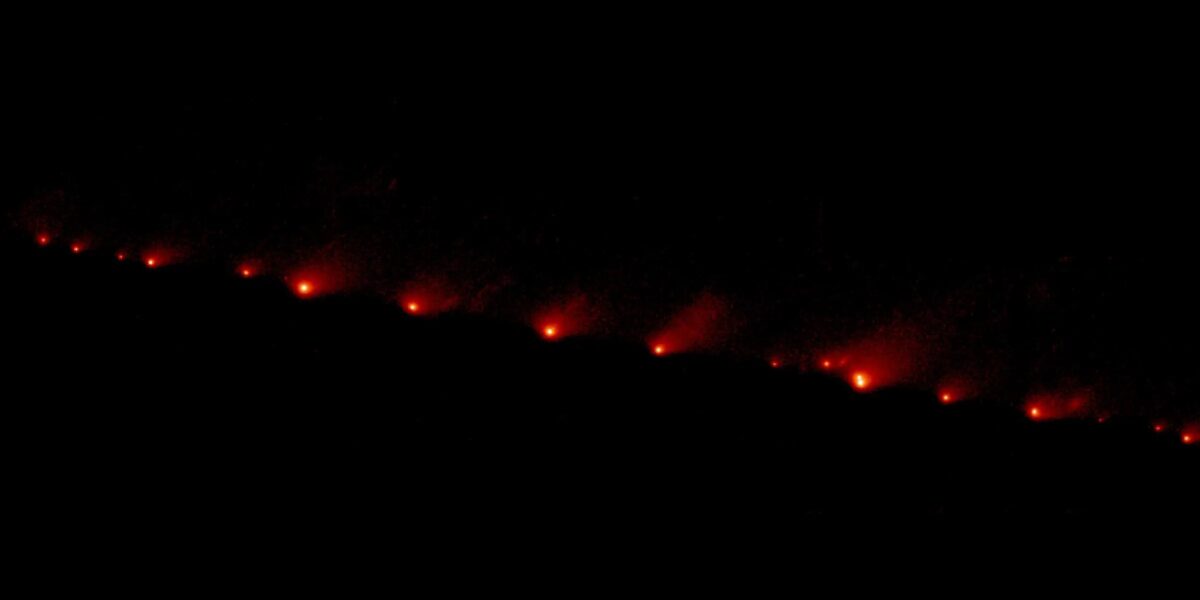
Over six dramatic days in July 1994, a shimmering train of ice-encrusted particles slammed into Jupiter, the solar system’s largest and most massive planet. Like a celestial string of opalescent pearls, they impacted its swirling atmosphere with the explosive equivalence of 10 million megatons of TNT, thousands of times more energetically potent than Earth’s entire nuclear arsenal.
The direct hit on Jupiter by Comet Shoemaker-Levy 9 that summer sat on a destructive par with the Cretaceous-Paleogene extinction event that decimated three-quarters of earthly life, including all nonavian dinosaurs, 66 million years ago. And humanity was afforded a ringside seat as telescopes, spacecraft, astronomers, and a 1.6-million-strong online audience watched awestruck as nature did its ferociously brutal work.
A year earlier, the comet (and its intriguing backstory) had been totally unknown.
Spotting Comet Shoemaker-Levy 9
On March 24, 1993, husband-and-wife skywatchers Eugene and Carolyn Shoemaker and fellow astronomer David Levy were at California’s Palomar Observatory, seeking deep-space objects that might pose collisional risks to Earth. As the warm spring day surrendered to a mild nightfall in San Diego County, the observatory’s aging Schmidt telescope camera whirred and clanked obligingly into action.
Across six decades of service, this 18-inch (46 centimeters) instrument helped discover 100-plus supernova remnants, expanding astronomers’ knowledge of the stellar evolutionary lifecycle from cradle to grave. It also facilitated the comprehensive survey, photography, and mapping of hundreds of asteroids and dozens of comets. But if the Shoemakers and Levy sought potential Earth impactors that night, a surprise lay in store.
The 13.8-magnitude comet they found was unusual in the extreme. A squashed blob, it exhibited “a dense, linear bar … oriented roughly east-west; no central condensation was observable,” they wrote, “but a fainter, wispy ‘tail’ extended north of the bar and to the west.” As the ninth periodic comet found by the trio, it earned the moniker Shoemaker-Levy 9 and entered the International Astronomical Union (IAU) Circular 5725 on March 26.
A necklace of objects

By then, it had caused quite a stir. Observations by Jim Scotti at Kitt Peak, near Tucson, Arizona, revealed a long, narrow train of objects, shattered into fragments with at least five discernible groupings that brightened near their southwestern end. Forty-seven arcseconds long — about 710,000 miles (1.1 million kilometers) or three times the Earth-Moon distance — it was a thousand times too faint to be seen with the naked eye.
And when a number of precovery observations from the mid-March timeframe also came to light, IAU Central Bureau for Astronomical Telegrams Director Brian Marsden mapped Shoemaker-Levy 9’s orbital parameters, revealing its tantalisingly close proximity to Jupiter. “The comet is located some four degrees from Jupiter,” he wrote, “and the motion suggests it may be near Jupiter’s distance.”
As those parameters firmed-up with greater confidence, it became apparent that Shoemaker-Levy 9 occupied a loose, highly eccentric orbit, circling Jupiter every two years. It likely originated as a short-period comet orbiting from slightly interior of the asteroid belt at perihelion to just inside Jupiter’s orbit at aphelion.
An oddball orbit
Nudged out of solar orbit and into the jovian sphere of influence between the mid-1960s and early 1970s — astronomers Ed Bowell and Lawrence Wasserman calculated a date around 1966 — this Jupiter-grazing trajectory set it on an irreversible path toward its doom.
Over the succeeding years, Shoemaker-Levy 9 made several approaches to its huge host, the nearest and most catastrophic in July 1992, when it swept 25,000 miles (40,000 km) above Jupiter’s cloud-tops.
Passing interior of the orbit of the innermost jovian moon, Metis, that close shave sounded the comet’s death-knell. For it also carved a fateful path deep inside Jupiter’s Roche Limit — the area within which the planet’s tidal forces are sufficiently strong to disrupt and break apart smaller celestial interlopers held together by gravity alone.
Between 1.5 and 2.2 hours after its close graze, the comet fractured into at least 21 pieces, which after its March 1993 discovery were named A through W, excluding I and O, with Q —near the center — identified as the brightest and likely the biggest. But exact numbers proved unknowable, for imaging limitations and the fragments’ obscurement by dust made it difficult to resolve tinier chunks or ascertain if larger ones were actually multiples.
The impending collision of Comet Shoemaker-Levy 9

In May 1993, Marsden predicted the comet’s future trajectory would carry it within 28,000 miles (45,000 km) of Jupiter’s center, a distance smaller than the planet’s radius. And from that prediction sprang a single, indisputable conclusion: Shoemaker-Levy 9 would hit Jupiter in July 1994 — the first time humanity had predicted a collision between two solar system objects more than a few minutes in advance.
The impact would shed new light on both planet and comet. It would inject matter from the deep jovian interior into the upper atmosphere, furnishing spectroscopic insights of Jupiter’s unexplored depths and yielding clues about cometary dynamics and evolution. Some gaseous species might condense into clouds, their spreading characteristics churning up volatiles like water, ammonia, and hydrogen sulphide.
Understanding the longevity of Jupiter’s centuries-old storms, spots, and eddies drew acute interest. Some argued the impact might besmirch its atmosphere for months, perhaps creating a new storm up to 1,500 miles (2,400 km) wide. Others countered that the comet’s diminutive size and density would impart few long-term effects.
Determining that size and density would enable astronomers to pin down how much punch Shoemaker-Levy 9 might pack. Computational dynamics, reflectivity characteristics and the comet’s observed behavior implied a density of 0.018 pounds per cubic inch (0.5 grams per cubic cm) — less dense than water. But speculation that the fragments were smaller than 1,600 feet (500 meters) was soon called into question.
Data from the Hubble Space Telescope in July 1993 suggested fragment sizes of 1.8 miles to 2.5 miles (2.9 to 4 km) that permitted an extrapolation of the comet’s pre-breakup dimensions of up to 7 miles (10 km). Later Hubble images refined those fragment-size limits downward to the order of 0.6 miles (1 km) or less.
With Jupiter some 534 million miles (860 million km) from Earth at the point of impact, the effects of the collision would prove hard to see. But one thing was certain: giant Jupiter was in for a beating.
Capturing the crash
Approaching from the south at 130,000 mph (210,000 km/h) and colliding south of the planet’s South South Temperate Belt at 45 degrees South latitude, all Shoemaker-Levy 9’s fragments were predicted (with 99.9-percent certainty) to meet their end on the jovian farside, agonisingly out of view of earthly telescopes.
But fast-spinning Jupiter revolves on its axis every 9.5 hours, meaning the carnage would rotate quickly into view minutes after each collision. As ground-based skywatchers hoped to see impact flashes reflected off the planet’s innermost moons, Hubble closely watched the comet and Jupiter’s atmosphere before and after the event.
Elsewhere, the Galileo spacecraft — en route to a December 1995 arrival at Jupiter — had direct visibility of those impact flashes from a distance of 150 million miles (240 million km). The Sun-circling Ulysses probe, 240 million miles (390 million km) south of Jupiter, also had line-of-sight visibility for radio observations. And Voyager 2, some 4.1 billion miles (6.6 billion km) from the action, would still be able to watch from afar.
The big crash
Late on July 16, 1994, Fragment A penetrated the Jovian clouds at 35 miles (60 km) per second. Moments later, Galileo detected a fireball that peaked at 42,700 degrees Fahrenheit (23,700 degrees Celsius) and Hubble witnessed a mushroomlike plume rising 1,900 miles (3,000 km).
On Earth, keen-eyed observers witnessed the fireball at Jupiter’s limb just after the collision, nixing predictions that astronomers would be unable to see them. A dark, spotlike feature quickly formed at the impact site.
By far the largest-yield collision was Fragment G, whose July 18 impact carried a potential of 6 megatons of TNT, 600 times stronger than all humanity’s nuclear munitions. It left a dark spot 7,500 miles (12,000 km) across, almost as wide as Earth. Two impacts a half-day apart on the 19th also left scars and the last — Fragment W — ended the onslaught on July 22.
Planet-wide effects were profound, from intense auroral activity in the northern hemisphere to colossal waves that swept Jupiter at 1,000 mph (1,600 km/h) for two hours after the bigger impacts. Elevated temperatures oddly dropped to normal levels more quickly at larger impact sites than smaller ones. And global stratospheric temperatures returned to normal within two to three weeks.
Shoemaker-Levy 9 revealed clues to Jupiter’s interior. Ammonia and hydrogen sulphide were found in greater quantities than would be expected from a comet. Significant amounts of water were detected spectroscopically and ammonia and carbon disulphide remained in the jovian stratosphere — higher than their usual location in the troposphere — over 14 months after the impact.
Related: 15 greatest comets of our time
Impact dynamics showed Shoemaker-Levy 9’s structural strength was quite low, implying the original comet was only 1.1 miles (1.8 km) across. Hubble revealed its fragments were solid, massive objects. Astronomers at Mauna Kea, Hawaii, identified carbon monoxide, sodium, magnesium, calcium, and manganese — all affording evidence about the chemical makeup of this ancient body.
Absorbing asteroids
Meanwhile, mighty Jupiter weathered the storm. Global maps from Hubble in August 1994 showed easterly and westerly atmospheric jets gradually softening the dark spots’ edges. Impact sites remained but scarring slowly receded. Yet for months, they remained more easily visible even than the famous Great Red Spot. Today, Shoemaker-Levy 9 remains the most prominent transient feature ever seen on the planet.
It was neither the first nor last time Jupiter was thus brutalised. In 2009, a Pacific-sized dark spot in its southern hemisphere appeared, likely due to an asteroid twice as big and thousands of times more powerful than the Tunguska impactor which hit Siberia in 1908. More recently, the Jupiter-orbiting Juno probe witnessed an impact fireball in 2020 and amateur skywatchers captured another on video in 2023.
Like the biblical David, Shoemaker-Levy 9 struck Jupiter a glancing, punishing blow over those six dramatic days of July 1994. But Jupiter’s Goliath has long been a benevolent giant: For eons, its size, mass, and immense gravity have drawn and consumed comets and asteroids. In so doing, it has removed hazardous impactors that might have savagely pummelled the inner solar system and eliminated the slimmest chance of complex life ever arising on Earth.









